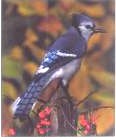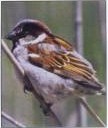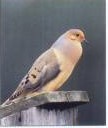|

ęCopyright 1993-2002 The L. W. Ramsey Agency 1-800-473-0157
|
How to Attract Birds
From gulls that follow in the
wake of ships to crows that stay close behind the plow, birds have been
a natural companion of man for ages.

Create the right environment for them around your home today and you will
not only help them survive but you will also enjoy their company and entertainment
throughout the year. Feeding birds around the calendar is a good choice.
Remember that birds have little choice in winter when once they become
dependent on your feeding station. Continue to supply them until natural
foods are available for them in the spring.
Because they start feeding at sunup, make sure your feeders are ready
for business by filling them in the evening. Birds will find your provision
for them -- shelter, water and food -- when you make the effort to welcome
them in the following ways.
Natural Shelter and Special Housing Top
of Page
Evergreens and hedges near your feeding location will not only provide
summer nesting sites, but also places to roost out of the winter winds.
If well constructed and sited, nesting boxes to fit species from wood
ducks to wrens usually attract tenants interesting to see and a pleasure
to hear. Another benefit is provided by a colony of martins, experts at
clearing out mosquitos and other night insects. Because martins will also
eat dragonflies, another enemy of the mosquito, swifts and swallows may
be more welcome as the evening airforce.
Bird Houses -- Build or
BuyTop of Page
Various styles and sizes of bird houses are available at most nurseries
or pet supply shops. Hole size is important and must fit the size of bird
you want to attract. Wren houses should have a 1-inch hole while bluebirds
require a 1-1/2-inch entrance.

When building your own bird houses, remember to incorporate drainage holes
in the floor and air conditioning openings at the top. And make provision
for easy cleanout at the end of the season with a trap door or removable
bottom.
Water Sends up its Own Signal Top
of Page
To birds in flight, your birdbath mirrors the sky and is an easily seen
invitation to stop for a drink or a dip. The best designs have a gradual,
sloping rim where your guest can wade in, but big flowerpot saucers and
container lids may also be used. The most attractive baths include a fountain
or dripping water to add some sound and action; robins enjoying a spinning
garden sprinkler show the strength of this appeal. Because birds need
water in winter too, automatic electric heaters may be used to prevent
icing.
 |
Using Plants
to Attract Birds
Bending to the ground with loaded seedheads, the yellow sunflower
looks like the original golden arches to a great many hungry birds
beside the predictable golden finches. Sunflowers are
easy to plant year after year, but there are also many shrubs and
trees that are natural food sources season after season. Elderberry
attracts about as many species as sunflowers, and is an effective
feeder from midsummer through fall. As for vines, the trumpet vine
can be home for cardinal nests, and provides nectar for hummingbirds.
The twining bittersweet sets out attractive berries in the
fall that also make attractive dried arrangements for indoors. |
Shrubs and Trees for Birds
to Feed onTop
of Page
The Russian olive tree, flowering dogwood, and juniper
trees and shrubs produce fruit that is available to birds all winter.
Viburnum, red cedar, hawthorn and holly are
also natural food producers for the cold, dark months.
|
A menu of other trees
and shrubs to consider for attracting birds would include wild
plum, cherry, crabapple and honeysuckle. Your choice will
depend on local climate, soil, and available space in your yard.
For specific answers to this important part of your birdlife program,
see your nursery center or contact the county office of the Agricultural
Extension Service.
Feeders that Welcome
Birds -- and Keep Them Top
of Page
Feeding stations should be placed where you can see them from the
house, but also near shrubbery or other bird shelter.Remember the
importance of wind shelter in the design of the feeder itself, too.
Pole-mounted types, hanging types, window-mounted feeders, ground-level
stations like a horizontal windowscreen on legs can all be successful.
|
|

Some Feeder
Features to Look forTop
of Page
Whether you purchase or build a feeder, ease of filling and cleaning,
and a protected seed hopper large enough for several day's use should
be a consideration. Unless it is supplied at time of purchase, you might
want to build your own hanging screen-table for underneath the popular
thistle-seed feeders. It will conserve seed and reduce their sprouting
in your yard or garden below.
Here from the U.S. Fish
and Wildlife Service, Urban Wildlife Research Program is a menu of preferred
foods for 17 common birds.
Preferred Foods of Common
BirdsTop of Page
 American
Goldfinch: Sunflower kernels and pieces, American
Goldfinch: Sunflower kernels and pieces,
, oil-type sunflower seeds, Niger seeds
 Blue Jay: All types
of sunflower seeds, and peanut kernels Blue Jay: All types
of sunflower seeds, and peanut kernels
Catus Wren: Peanut kernels, and Suet/Cakes
  Cardinal:
All types of sunflower seeds and Safflower Cardinal:
All types of sunflower seeds and Safflower
Cedar Waxwing: Bush berries; no seeds
 Chickadee: Sunflower
kernels and pieces, striped sunflowers, Niger seed, and Safflower Chickadee: Sunflower
kernels and pieces, striped sunflowers, Niger seed, and Safflower
Curved-billed Thrusher:
Milet and milo
 Dark-eyed Junco:
Canary seed, finely cracked corn, and Millet Dark-eyed Junco:
Canary seed, finely cracked corn, and Millet
Evening Greosbeak:
All types of sunflower seeds and finely cracked corn
 Evening Grosbeak: All
types of sunflower seeds and finely cracked corn Evening Grosbeak: All
types of sunflower seeds and finely cracked corn
Gamble's Quail:
All types of sunflower seeds, Millet, peanut kernels, and milo
Gila Woodpecker:
All types of sunflower seeds, peanut kernels, and nectar
 House Finch: Striped
sunflower seeds, sunflower kernels and pieces, oil type sunflower seeds,
Niger seeds, and Safflower House Finch: Striped
sunflower seeds, sunflower kernels and pieces, oil type sunflower seeds,
Niger seeds, and Safflower
 House Sparrow: All
types of sunflower seeds, crary seed, finely cracked corn, and millet House Sparrow: All
types of sunflower seeds, crary seed, finely cracked corn, and millet
Mountain Chickadee:
Striped sunflower seeds and oil type sunflower seeds
 Mourning Dove: Millet,
Niger seeds, oil type sunflower seeds, and Safflower Mourning Dove: Millet,
Niger seeds, oil type sunflower seeds, and Safflower
Nut Hatch:
Striped and oil type sunflower seeds, peanut kernels, and Safflower
 Purple Finch: All
types of sunflower seeds, Niger seeds, and Safflower Purple Finch: All
types of sunflower seeds, Niger seeds, and Safflower
Pyrrhuloxia:
All types of sunflower seeds and peanut kernels
Red Shafted Flickers:
Peanut kernels and Safflower
Scrub Jay:
Oil type sunflower seeds, finely carcked corn, and peanut kernels
 Song Sparrow: Millet Song Sparrow: Millet
 Tufted Titmouse: Striped
and oil type sunflower seeds, peanut kernels, and Safflowers Tufted Titmouse: Striped
and oil type sunflower seeds, peanut kernels, and Safflowers
Verdin: Nectar
Warbler: Insects
Western Bluebird:
Insects
 White-crowned Sparrow:
Sunflower kernels and peices, oil type sunflower, Millet, peanut kernels
and hearts, Niger seeds White-crowned Sparrow:
Sunflower kernels and peices, oil type sunflower, Millet, peanut kernels
and hearts, Niger seeds
 White-throated Sparrow:
Striped sunflower, sunflower kernels and peices, oil type sunflower seeds,
Millet, peanut kernels White-throated Sparrow:
Striped sunflower, sunflower kernels and peices, oil type sunflower seeds,
Millet, peanut kernels
White-winged Dove: All types of sunflower seeds, Millet,
and milo
Woodpeckers:
 Downy, Downy, Hairy, Hairy, Red-Bellied Red-Bellied
All types of sunflower seeds, and suet/cakes
Photos Courtesy of...
Cornell
Lab of Ornithology
Over 1100 bird slides.
Call (607) 254-2450. |
Chips
Cards, Inc.,
Manufacturers and
producers of collectible
and educational nature
trading cards. |
For
samples and
product information
call 1-800-837-BIRD. |
Sunflower -- The Basic Wildbird
Seed
Perhaps the most popular wild bird seed is the sunflower, available as
thinshell black oilseed, or striped types, whole or hulled. There is no
spring cleanup required with the latter. Periodically, be sure to remove
and destroy moldy feed seeds to protect your birds from disease.
Serving up a Power Diet
Top
of Page
 Birds require these types of
concentrated high-energy foods for daily activity and for keeping warm
on winter nights. Black sunflower oil seeds are preferable to the larger
striped seeds for this, and peanut products are another good high-calorie-per-weight
alternative. The classic concentrated food is animal suet. This can be
fed in a wire mesh cage on the side of a tree or post, in a hanging plastic
onion-net bag, or in a hanging log specially bored for plugging with this
hard, waxy fat. Birds require these types of
concentrated high-energy foods for daily activity and for keeping warm
on winter nights. Black sunflower oil seeds are preferable to the larger
striped seeds for this, and peanut products are another good high-calorie-per-weight
alternative. The classic concentrated food is animal suet. This can be
fed in a wire mesh cage on the side of a tree or post, in a hanging plastic
onion-net bag, or in a hanging log specially bored for plugging with this
hard, waxy fat. 
The Readymade
Seed Mixes --
Too Much Millet?Top
of Page
Prepared feed mixes make feeding easier, but check them for the proportions
of red millet and grain sorghum (milo). These lower the cost of ready-mixed
bags but also attract pigeons, blackbirds, and grackles, and may require
increased spring cleanup of rejected grains.
Some Common PreferencesTop
of Page
High-octane fuel for ground-feeders like doves and juncos should include
cracked corn or white millet. For goldfinches or purple finches
and pine siskins, hulled sunflower seed or Niger from a vertical
tube feeder are top choices. If you mix your own treats for birds, as
with peanut butter or suet, remember to include a small fraction of sand
to provide grit necessary to these toothless diners. The red-bellied
woodpecker is a suet-eater who will also eat cracked corn. Blue
jays will go for either corn or sunflower seed, also a favorite of
the house sparrow.
HummingbirdsTop of
Page
 |
Perhaps the
most exciting and colorful gourmets to attract to your home are thehummingbirds.
About fifteen kinds enter the United States, mostly in the Southwest,
but the Rubythroat can be found almost everywhere east of the
Missouri River and across southern Canada. |
Migration takes it across
the Gulf of Mexico, 500 miles on about 2 grams of fat. A real acrobat,
the hummingbird has been clocked at speeds of over 50 miles an
hour, yet can hover motionless and fly backwards in its feeding activity.
Specialized feeders are required for these guests, and also special food
in the form of imitation nectars. Whatever the feeder design, their attraction
is in the use of red blossom shapes, with a reward of prepared nectar.
If you make your own treat for these feeders, avoid using honey, which
can mold easily. One part of sugar to four parts of water by volume, boiled,
is a suggested recipe. Have your hummingbird station ready in early spring.
Some of their favorite natural fly-ins include honeysuckle, petunias,
phlox, nicotiana, azaleas and trumpetvine. They'll help you keep you yard
clear of insects too!
Pest ProblemsTop
of Page
|
You are the innkeeper,
and it's your decision to feed all comers or just the smaller birds.
With perch-type feeders, reducing the length of the pegs will make
it harder for grackles or cowbirds, for example to get a toehold.
In spite of all your care, it can still be a jungle out there, with
the presence of hungry squirrels or predatory cats.
With squirrels, the
object is to keep the raider away from the feeding shelf and the
seed reserve. Ingenious feeder designs that lock up or trip under
the weight of squirrels, and floppy guards that defy the offender
when it tries climbing the feeder pole are two types of protection.
|
 |
The best Niger feeders have
seed ports armored with metal shields to protect against gnawing squirrels.
Dropping down from a tree branch high overhead, squirrels have even broken
feeding stations off their mountings. One response
 |
is
to build strong feeders in the first place, be prepared to devise
countermeasures, and to enjoy the daily exploits of these wily, four-footed
foragers. Another alternative is to set up a squirrel feeding station
with ear corn or some other favorite food at a distance from the bird
feeder. This, however may also be attractive to raccoons or possums.
T. and T. is another solution -- trapping and transporting. Box-type
traps are humane, but should be opened at a remote destination as
soon as possible to release the offender. |
 If
the cat is your own, you can keep it indoors at feeding time. If
the cat is your own, you can keep it indoors at feeding time.
For neighborhood cats, try to allow as little cover as possible -- make
it easy for birds to see the danger. And hang feeders high up -- cats
can leap more than four feet off the ground to bring down their prey.
Now Add to Your EnjoymentTop
of Page
Keep a pair of binoculars handy, together with an illustrated guidebook
for bird identification. Watch how the goldfinches dress up for spring
and look for new visitors passing through as the seasons change. You'll
enjoy these customers more, just knowing how you've helped them with a
healthful menu at your feeding stations.
Getting StartedTop
of Page
- Pick location
·near nesting sites?
·protection from wind?
·good view from house?
- Birdhouses for small birds
- Birdhouses for larger birds
(bigger than 1-1/2" hole)
- Martin houses
- Hummingbird station
- Suet cage or log
- Screen table to catch seed
- Bird book to identify species
- Bird seed (see table inside)
- Squirrel feeder
- Binoculars
- Birdbath
- Bird feeder
Some facts may vary by
region. Please check with your local lawn and garden dealer if concerned
about possible variations. |

